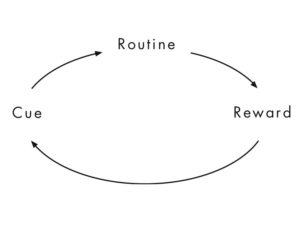Daily doers write every day. Researchers have found there are many benefits to having a daily writing routine – yet there are also downsides. Find out how to trigger a regular writing habit and make the most of this approach to finding writing time in your busy life.
The 4 approaches for making time to write
We’ve asked over 3,500 writers how they fit writing into their life and found four approaches:
- Daily writer: has a daily writing routine
- Time boxer: schedules time to write across a week
- Spontaneous: grabs any opportunity to write
- Binge: has rare sessions to binge write
This post explores how to make the most of a daily writing routine. But explore the other approaches (see links above) to see if they work for you at different times in your day or across your writing life.
>> Read more: How to make time to write – 4 approaches to finding time in busy schedules
Daily writer – turns up to write every day
A daily doer has a regular routine, often working in the same time and place to nudge forward their writing. They thrive when they have a predictable writing habit.
It is less about the amount of time they work for, and more about the routine, showing up each and every day to make consistent progress.
The regularity makes daily doers highly productive – lots of research* backs this up – but their love of process can mean that they resist going off on creative tangents and stepping outside a routine.
“Daily doer – a writer who likes regularity, structure and routine.”
Benefits of having a daily writing practice
Daily writers have overcome one of the biggest barriers to finding a writing routine: grappling with willpower. Because of their regular habit, they just need to show up at the right time and place and pick up where they left off.
They report feeling happier and more fulfilled with their writing as they are in constant touch with it.
If one session doesn’t go so well, they just turn up the next day, and the next. They are often better able to weather the ups and downs of writing, overcome blocks by writing through them and still make consistent progress.
Downsides of a daily writing practice
Sticking with a fixed time to write means that some daily doers don’t take advantage of their peak writing times according to their natural body clocks. This is especially the case when people get up earlier and earlier to write and end up feeling exhausted.
Also, the fixed time means they might miss the breakthroughs that come with working at different times of the day. Researchers have found people to be more creative at the opposite time of their peak productivity.
Finally, when we researched the writing habits of 600 academic writers we found that whilst daily doers were the most satisfied types of writer, they weren’t necessarily the most productive.
How to create a daily writing routine
If you want to develop a daily writing practice it helps to understand how habits work.
Author Charles Duhigg referred to the habit loop as “a framework for understanding how habits work and a guide to experimenting with how they might change.”
This is important because there is no magic formula to create a habit – some tasks are easier than others, while others take more time and effort to stick. Some argue that writing can never become a habit, because habits are done ‘unthinkingly’ without conscious effort – writing demands a lot of effort. However, you can use the loop to embed the routine of showing up each day to write.
Duhigg suggests four steps:
1. Identify the routine
The first part of this is simple – you want to develop a writing routine. Next, take time to consider what this routine might look like. When do you want to write, where, what will you do when you show up each day?
>> Read more: How small steps lead to great progress
2. Experiment with rewards
Rewards are essential in embedding a routine. They help us stick with something because we associate the task with something pleasurable. This association gets fixed in the brain and makes us more likely to continue with the routine.
Have some fun experimenting with rewards, give yourself something to look forward to at the end of a writing session. One trick we suggest is to use your procrastination tendencies as rewards rather than delaying tactics. In short – social media after writing not before!
3. Isolate the cue to write
A cue sets up the routine. Think of habits you do unthinkingly, especially bad ones, such as every time you buy a coffee from your favourite café you pick up a brownie on the counter. The café has designed the counter layout to trigger a behaviour and after you’ve bought a brownie a few times, you’ll quickly embed the habit as the reward is so delicious.
Duhigg found that almost all cues fit into one of five categories. These can be used to break bad habits, but also exploring them can help you to trigger new ones.
- Location – where do you want to write?
- Time – at what time?
- Emotional state – how are you feeling?
- Other people – who else is around?
- Immediately preceding action – what do you do beforehand?
4. Have a plan
It can take a while to embed a writing routine, and once you have one, they can be easily lost. Rather than rely on willpower you need a plan.
Once you’ve identified when and where you’ll write, then create plan – this is as simple as noting it down, for example: “I will write every week day at 8am for one hour at the café opposite the train station.”
This example is clear and specific, it uses an everyday activity like commuting to attach the new writing behaviour to. It gives a time and regularity so it’s clear when it’s been achieved and has the bonus of building in a reward.
>> Read more: How to set a writing goal: the ultimate guide
Some people benefit from telling others, so it might help to share your plan and enlist support from friends, family or co-workers, or go public and share with online communities.
“Show up, show up, show up, and after a while the muse shows up, too.” Isabel Allende
Finally, don’t punish yourself
Don’t be too ambitious when setting up a routine – don’t to punish yourself or set yourself up to fail. For example, many writers plan on getting up at 5am to write before the day’s demands, then fail, feel bad and enter a negative cycle of inaction. If you want to get up earlier, start with increments of 10 or 15 minutes until you work out when’s the earliest you can manage.
Start small, bag some quick wins and the positive reinforcement will help you write for longer.
Once you’ve established a routine allow some flexibility for change and interruption. Don’t be too tough on yourself and others if you can’t make a session.
Finally, notice opportunities outside of your routine for extra writing – it might be scheduling a longer session to take a deep dive, or just grabbing a few minutes for spontaneous creativity.
Remember to keep flexible. How you write will change over your current writing project, between different types and genres of writing and across your writing life. Keep experimenting with different approaches to writing, Combining daily writing writing with spontaneous writing, time boxing or binge writing means you can really boost your output. And if you get to busy to write every day, swap it out for a less frequent approach.
*Robert Boice, Procrastination, busyness and bingeing, Behaviour Research and Therapy, Volume 27, Issue 6, 1989, Pages 605-611





